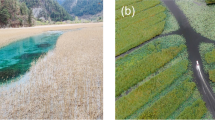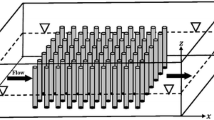Abstract
Riparian and floodplain tree-like emergent vegetation alter significantly the flow field and lead to complicated three-dimensional flow patterns, characterized by increased turbulence production, with the potential to induce morphological changes. The canopy presence in tree-like vegetation leads to the formation of lee wake vortices and can induce a strong subcanopy flow. The present experimental study employs artificial, rigid, tree-like emergent vegetation elements, with relatively simple structure, in order to investigate the canopy effects on the flow field. Specifically, the tree-like canopy is simulated by placing an element on top of a wooden rod simulating the trunk. Three elements with an equal encircling diameter of 16 cm are examined as canopy in tree-like vegetation, namely a circular cylinder and two hexagonal arrays comprising smaller circular cylinders with two different individual diameters. The experiments were conducted in a 26 m long laboratory flume and the velocity measurements were carried out with an acoustic Doppler velocimeter. The results show that the canopy porosity has a direct impact on the subcanopy flow intensity and on the required distance that the flow needs to recover. In addition, the subcanopy flow disrupts the formation of a steady wake region behind the entire porous element and inhibits the development of a recognizable von Karman vortex street.

















Similar content being viewed by others
References
Gran K, Paola C (2001) Riparian vegetation controls on braided stream dynamics. Water Resour Res 37(12):3275–3283. doi:10.1029/2000WR000203
Gurnell A (2014) Plants as river system engineers. Earth Surf Process Landf 39:4–25. doi:10.1002/esp.3397
Tsujimoto T (1999) Fluvial processes in streams with vegetation. J Hydraul Res 37(6):789–803. doi:10.1080/00221689909498512
Chen Z, Ortiz A, Zong L, Nepf H (2012) The wake structure behind a porous obstruction and its implications for deposition near a finite patch of emergent vegetation. Water Resour Res 48(9):W09517. doi:10.1029/2012WR012224
Ortiz AC, Ashton A, Nepf H (2013) Mean and turbulent velocity fields near rigid and flexible plants and the implications for deposition. J Geophys Res 118(4):2585–2599. doi:10.1002/2013JF002858
Corenblit D, Steiger J, Gurnell AM, Tabacchi E, Roques L (2009) Control of sediment dynamics by vegetation as a key function driving biogeomorphic succession within fluvial corridors. Earth Surf Process Landf 34(13):1790–1810. doi:10.1002/esp.1876
Gurnell AM, Bertoldi W, Corenblit D (2012) Changing river channels: the roles of hydrological processes, plants and pioneer fluvial landforms in humid temperate, mixed load, gravel bed rivers. Earth Sci Rev 111(1–2):129–141. doi:10.1016/j.earscirev.2011.11.005
Nikora V (2010) Hydrodynamics of aquatic ecosystems: an interface between ecology, biomechanics and environmental fluid mechanics. River Res Applic 26:367–384. doi:10.1002/rra.1291
Aberle J, Jarvela J (2013) Flow resistance of emergent rigid and flexible floodplain vegetation. J Hydrau Res 51(1):33–45. doi:10.1080/00221686.2012.754795
Albayrak I, Nikora V, Miler O, O’Hare MT (2014) Flow-plant interactions at leaf, stem and shoot scales: drag, turbulence, and biomechanics. Aquat Sci 76:269–294. doi:10.1007/s00027-013-0335-2
Palmer MA, Bernhardt ES, Allan JD, Lake PS, Alexander G, Brooks S, Carr J, Clayton S, Dahm CN, Follstad Shah J, Galat DL, Loss SG, Goodwin P, Hart DD, Hassett B, Jenkinson R, Kondolf GM, Lave R, Meyer JL, O’Donnell TK, Pagano L, Sudduth E (2005) Standards for ecologically successful river restoration. J Appl Ecol 42(2):208–217. doi:10.1111/j.1365-2664.2005.01004.x
Beechie TJ, Sear DA, Olden JD, Pess GR, Buffington JM, Moir H, Roni P, Pollock MM (2010) Process-based principles for restoring river ecosystems. Bioscience 60(3):209–222. doi:10.1525/bio.2010.60.3.7
Camporeale C, Perucca E, Ridolfi L, Gurnell AM (2013) Modeling the interactions between river morphodynamics and riparian vegetation. Rev Geophys 51:379–414. doi:10.1002/rog.20014
Nepf HM (2012) Hydrodynamics of vegetated channels. J Hydraul Res 50(3):262–279. doi:10.1080/00221686.2012.696559
Hupp CR, Osterkamp WR (1996) Riparian vegetation and fluvial geomorphic processes. Geomorphology 14(4):277–295. doi:10.1016/0169-555X(95)00042-4
Bardossy A, Caspary HJ (1990) Detection of climate change in Europe by analyzing european atmospheric circulation patterns from 1881 to 1989. Theor Appl Climatol 42(3):155–167. doi:10.1007/BF00866871
Vreugdenhil SJ, Kramer K, Pelsma T (2006) Effects of flooding duration, -frequency and -depth on the presence of saplings of six woody species in north-west Europe. For Ecol Manag 236(1):47–55. doi:10.1016/j.foreco.2006.08.329
Ward JV, Tockner K, Arscott DB, Claret C (2002) Riverine landscape diversity. Freshwater Biol 47(4):517–539. doi:10.1046/j.1365-2427.2002.00893.x
Karrenberg S, Kollmann J, Edwards PJ, Gurnell AM, Petts GE (2003) Patterns in woody vegetation along the active zone of a near-natural Alpine river. Basic Appl Ecol 4(2):157–166. doi:10.1078/1439-1791-00123
Asaeda T, Gomes PIA, Sakamoto K, Rashid MH (2011) Tree colonization trends on a sediment bar after a major flood. River Res Applic 27(8):976–984. doi:10.1002/rra.1372
Mardhiah U, Rillig MC, Gurnell A (2015) Reconstructing the development of sampled sites on fluvial island surfaces of the Tagliamento River, Italy, from historical sources. Earth Surf Process Landf 40(5):629–641. doi:10.1002/esp.3658
Gurnell A, Petts G (2006) Trees as riparian engineers: the Tagliamento river, Italy. Earth Surf Process Landf 31(12):1558–1574. doi:10.1002/esp.1342
Finnigan J (2000) Turbulence in plant canopies. Annu Rev Fluid Mech 32:519–571. doi:10.1146/annurev.fluid.32.1.519
Belcher SE, Harman IN, Finnigan JJ (2012) The wind in the willows: flows in forest canopies in complex terrain. Annu Rev Fluid Mech 44:479–504. doi:10.1146/annurev-fluid-120710-101036
Gross G (1987) A numerical study of the air flow within and around a single tree. Bound.-Lay. Meteorol. 40(4):311–327. doi:10.1007/BF00116099
Pietri L, Petroff A, Amielh M, Anselmet F (2009) Turbulence characteristics within sparse and dense canopies. Environ Fluid Mech 9:297–320. doi:10.1007/s10652-009-9131-x
Bai K, Meneveau C, Katz J (2013) Experimental study of spectral energy fluxes in turbulence generated by a fractal, tree-like object. Phys Fluids 25:110810. doi:10.1063/1.4819351
Bai K, Meneveau C, Katz J (2012) Near-wake turbulent flow structure and mixing length downstream of a fractal tree. Bound.-Lay. Meteorol. 143(2):285–308. doi:10.1007/s10546-012-9700-2
Yagci O, Kabdasli MS (2008) The impact of single natural vegetation elements on flow characteristics. Hydrol Process 22(21):4310–4321. doi:10.1002/hyp.7018
Yagci O, Tschiesche U, Kabdasli MS (2010) The role of different forms of natural riparian vegetation on turbulence and kinetic energy characteristics. Adv Water Resour 33(5):601–614. doi:10.1016/j.advwatres.2010.03.008
Yagci O, Celik MF, Kitsikoudis V, Kirca VSO, Hodoglu C, Valyrakis M, Duran Z, Kaya S (2016) Scour patterns around individual vegetation elements. Adv Water Resour 97:251–265. doi:10.1016/j.advwatres.2016.10.002
Takemura T, Tanaka N (2007) Flow structures and drag characteristics of a colony-type emergent roughness model mounted on a flat plate in uniform flow. Fluid Dyn Res 39(9–10):694–710. doi:10.1016/j.fluiddyn.2007.06.001
Nicolle A, Eames I (2011) Numerical study of flow through and around a circular array of cylinders. J Fluid Mech 679:1–31. doi:10.1017/jfm.2011.77
Zong L, Nepf H (2012) Vortex development behind a finite porous obstruction in a channel. J Fluid Mech 691:368–391. doi:10.1017/jfm.2011.479
Chang K, Constantinescu G (2015) Numerical investigation of flow and turbulence structure through and around a circular array of rigid cylinders. J Fluid Mech 776:161–199. doi:10.1017/jfm.2015.321
Sumer BM, Fredsoe J (2002) The mechanics of scour in the marine environment. Advanced series on ocean engineering, vol 17. World Scientific, Singapore
Toney C, Reeves MC (2009) Equations to convert compacted crown ratio to uncompacted crown ratio for trees in the interior west. West J Appl For 24(2):76–82
Monleon VJ, Azuma D, Gedney D (2004) Equations for predicting uncompacted crown ratio based on compacted crown ratio and tree attributes. West J Appl For 19(4):260–267
Randolph KC (2010) Equations relating compacted and uncompacted live crown ratio for common tree species in the south. South J Appl For 34(3):118–123
Lynch TB, Budhathoki C, Wittwer RF (2012) Relationships between height, diameter, and crown for eastern cottonwood (populus deltoides) in a Great Plains riparian ecosystem. West J Appl For 27(4):176–186. doi:10.5849/wjaf.11-030
Goring DG, Nikora VI (2002) Despiking acoustic Doppler velocimeter data. J Hydraul Eng 128(1):117–126. doi:10.1061/(ASCE)0733-9429
Wahl TL (2003) Discussion of “Despiking acoustic doppler velocimeter data”. J Hydraul Eng 129(6):484–487. doi:10.1061/(ASCE)0733-9429
Mori N, Suzuki T, Kakuno S (2007) Noise of acoustic Doppler velocimeter data in bubbly flows. J. Eng. Mech. 133(1):122–125. doi:10.1061/(ASCE)0733-9399
Pope S (2000) Turbulent flows. Cambridge University Press, New York
Graf WH, Yulistiyanto B (1998) Experiments on flow around a cylinder; the velocity and vorticity fields. J Hydraul Res 36(4):637–654. doi:10.1080/00221689809498613
Roulund A, Sumer BM, Fredsoe J, Michelsen J (2005) Numerical and experimental investigation of flow and scour around a circular pile. J Fluid Mech 534:351–401. doi:10.1017/S0022112005004507
Unger J, Hager WH (2007) Down-flow and horseshoe vortex characteristics of sediment embedded bridge piers. Exp Fluids 42(1):1–19. doi:10.1007/s00348-006-0209-7
Tanaka N, Yagisawa J (2010) Flow structures and sedimentation characteristics around clump-type vegetation. J Hydro-Environ Res 4(1):15–25. doi:10.1016/j.jher.2009.11.002
Valyrakis, M., Kitsikoudis, V., Yagci, O., Kirca, V.S.O., Koursari, E.: Experimental investigation of the modification of the flow field, past emergent aquatic vegetation elements. In: Proceedings of the 36th IAHR Congress. The Hague, The Netherlands (2015)
Wallace JM (2016) Quadrant analysis in turbulence research: history and evolution. Annu Rev Fluid Mech 48:131–158. doi:10.1146/annurev-fluid-122414-034550
Nelson JM, Shreve RL, McLean SR, Drake TG (1995) Role of near-bed turbulence structure in bed load transport and bed form mechanics. Water Resour Res 31(8):2071–2086. doi:10.1029/95WR00976
Siniscalchi F, Nikora VI (2012) Flow-plant interactions in open-channel flows: a comparative analysis of five freshwater plant species. Water Resour Res 48(5):W05503. doi:10.1029/2011WR011557
Strang G (2009) Introduction to linear algebra. Wellesley-Cambridge Press, Wellesley
Sumer BM, Fredsoe J (1997) Hydrodynamics around cylindrical structures. Advanced series on ocean engineering, vol 12. World Scientific, Singapore
Acknowledgements
Vasileios Kitsikoudis gratefully acknowledges the financial support for conducting post-doctoral research in Istanbul Technical University, initially from Anastasios Anastasiadis foundation (grant number 63310/25-09-2013) and afterwards from the Scientific and Technological Research Council of Turkey (TUBITAK)—Fellowship Program 2216 (Ref. No. 21514107-115.02-45898). The authors would like to thank the Editor in Chief for handling the manuscript and two anonymous Reviewers, whose insightful comments and constructive suggestions improved the technical content and presentation of the paper. Finally, thanks go to ITU Hydraulics Laboratory technicians Mevlut Ulucinar, Hasan Yalcin, and Yasar Aktas.
Author information
Authors and Affiliations
Corresponding author
Rights and permissions
About this article
Cite this article
Kitsikoudis, V., Yagci, O., Kirca, V.S.O. et al. Experimental investigation of channel flow through idealized isolated tree-like vegetation. Environ Fluid Mech 16, 1283–1308 (2016). https://doi.org/10.1007/s10652-016-9487-7
Received:
Accepted:
Published:
Issue Date:
DOI: https://doi.org/10.1007/s10652-016-9487-7




